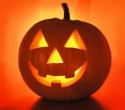The History of Halloween

It’s the time of year when you can walk down your street and see not only the glorious colours of fall, squirrels gathering nuts for winter, and colourful leaves floating around your head, but also the familiar sights of leering jack o’ lanterns; toothy, grinning skeletons; and sneering, crusty witches.
What the heck?
Hallowe’en is the time of year when the veil between the worlds of the living and the dead is at it’s thinnest. It’s believed spirits can cross over from their ethereal world of the non-living and interact with the living.
Historically speaking, Hallowe’en was a celebration of the end of summer and harvest, and the beginning of winter, be early Celts in Britain, Scotland, Ireland and northern France. 2,000 years ago, this celebration was called Samhain (pronounced Sow-ain) an old Irish word which means “summers end”. The Celts celebrated with bonfires, rituals, and dressing up in costumes to represent the spirits, both harmful and harmless, who were able to cross over. The Druids (spiritual leaders of the Celts) believed the less evil of the spirits could be called upon for divination or predicting the future of crops and weather, since these things affected people’s very existence and survival. For the most part, however, the spirits were feared as unknown creatures who could damage crops and play tricks on humans.
To the end, Jack o’ Lanterns were carved from turnips with evil faces meant to scare away the roaming spirits, and people wore masks to hide themselves and even scare the spirits away. The turnips, carved and lit, were also carried for the purpose of “souling” which was the act of going door to door offering prayers for the household’s dead in exchange for coins or food. This practice was typically enacted by the poorer folk of the time. From this, our modern trick-or-treating evolved.
As society progressed, and Christianity started to spread, the Romans realized they could not eradicate such deeply bound beliefs from people over night, so they chose to incorporate their own celebratory days into ones already in existence. For Samhain, this was All-Hallowmass, which was also known as All Souls Day, and was celebrated on November 1, honouring the dead. It too, was celebrated with costumes, although those were representative of angels, devils and saints, and with bonfires and parades too. Eventually this became known as All Hallows Even (evening), and today, Hallowe’en.
Currently, Hallowe’en is a special day geared for children, for the most part, although adults too enjoy the shenanigans. It’s a strictly secular event now, with costumes of monsters, celebrities, cartoon characters and those costumes are worn not to hide from evil spirits, but to entertain and scare each other. Candy is collected by trick-or-treaters, making this an extremely lucrative time of year for sweets merchandisers and dentists.
The only thing to fear these days are acts of evil by people around us. Children have been hurt and maimed by razor blades or pins inserted into treats, and in some cases, even drugs have been injected into foods. Parents are urged to check their children’s candy thoroughly after they return home, to hopefully prevent such a tragic mishap, but sadly, this isn’t always enough.
As in times of old, safety is still a factor in enjoying this event. Making sure to wear reflective clothing, visiting only homes you know, or attending a public event supported by local businesses are ways to protect yourself and your family and have a frightfully good time!





Laisser un commentaire!